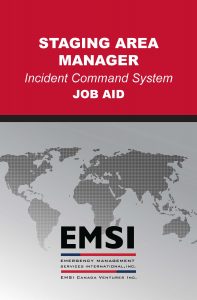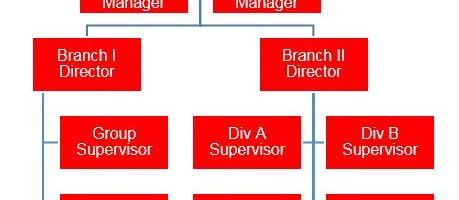Recognized as a critical element of the Incident Command System, Staging Areas are established to maintain a ready reserve of tactical resources and operational overhead to support evolving or emergent operational resource requirements. Staging Areas with adequate resource reserves are a critical component of maintaining a proactive posture on the incident and readiness to respond to contingencies. Often misunderstood to be part of the Logistics Section, Staging Areas are an organizational element of the Operations Section.
 Staging Areas are managed by a Staging Area Manager (STAM) who reports to the Operations Section Chief or Deputy. Staging Areas are usually organized by geographic location and are named as such (10th Street Staging, Hamilton School Staging, Mill Tide Marina Staging, etc.). The designated Staging Area Manager is responsible for all activities within that area, to include establishing, maintaining, check-in, storage, and distribution of all resources at staging. There may be more than one Staging Area on an incident and separate Staging Areas may be designated for land-based and maritime resources. Typically, aviation resources are staged at the Air Operations Base instead of a multi-resource staging area.
Staging Areas are managed by a Staging Area Manager (STAM) who reports to the Operations Section Chief or Deputy. Staging Areas are usually organized by geographic location and are named as such (10th Street Staging, Hamilton School Staging, Mill Tide Marina Staging, etc.). The designated Staging Area Manager is responsible for all activities within that area, to include establishing, maintaining, check-in, storage, and distribution of all resources at staging. There may be more than one Staging Area on an incident and separate Staging Areas may be designated for land-based and maritime resources. Typically, aviation resources are staged at the Air Operations Base instead of a multi-resource staging area.
The Operations Section Chief may identify the need for a Staging Area at any time, but this typically occurs in the initial response or as part of the IAP planning process during the Tactics Meeting or preparation for the Tactics Meeting. As part of the IAP planning process, the Staging Area is planned for in a similar fashion as a Division or Group; the Staging Area is noted on the Operations Section organization chart, is documented on the ICS-215 with required resources and logistical support requirements, and receives an ICS-204 in the IAP.
Like an Incident Command Post, Joint Information Center, or Incident Base, a Staging Area is considered an incident facility and the required logistical support requirements can be lengthy. While the direction to establish a Staging Area comes from the Operations Section Chief, the Logistics Section has a requirement to support the Staging Area as a facility. Once the need for a Staging Area is determined and a general area identified by the Operations Section Chief, the Staging Area Manager, along with the Logistics Section Chief and/or Facilities Unit Leader, will locate the best possible site. This includes coordination with the Finance/Administration Section to negotiate a lease and/or land-use agreement and the Safety Officer to inspect the site for potential safety hazards.
Once the site is acquired, the Staging Area Manager, along with support from the Logistics Section, will determine the layout to support the operational aspects of the Staging Area along with all of the associated support elements that will be co-located with the Staging Area. Depending on the activities within the Staging Area, the Logistics Section would provide shelter, security, signage, supplies, and other support items. The Staging Area Manager will work with all of the Unit Leaders within Logistics Section, but the most interaction usually occurs with Facilities Unit Leader and Supply Unit Leader. The Staging Area Manager will continually manage the Staging Area until it is no longer needed and then will work with the Logistics Section to return the site to its original condition as outlined in the lease/usage agreement.
As resources are assigned to a Staging Area, they are considered available to the Operations Section Chief for immediate reassignment to a Division or Group. They are considered “on the clock” or in “paid” status, as they must be available for immediate deployment in the Operations Section. This is different from resources that are “out-of-service” in a Base or Camp. Resources in a Staging Area must be available to deploy immediately (typically defined as five minutes or less) meaning they must be fully fueled, equipped, staffed, and ready for operations. This has led to a debate among ICS practitioners as to whether the status of resources in a Staging Area is “available” or “assigned”.
The Staging Area Manager plays a critical role in the resource management process. At the direction of the Operations Section Chief, Staging Area Managers may work with the Resources Unit Leader to assemble single resources into Strike Teams and Task Forces. Additionally, the Staging Area Manager may disassemble Strike Teams and Task Forces for assignment as single resources. With all resources assigned to the Staging Area available for reassignment in the Operations Section, the Staging Area Manager must keep the Resources Unit Leader and Operations Section Chief apprised of any changes to the status of any resource in the Staging Area including reassignment, out-of-service, or changes to Strike Teams and Task Forces.
Other activities can also occur at a Staging Area, such as:
- Check-in
- Situation displays
- Operational briefings and debriefings
- Safety briefings and inspections
- Responder Medical Aid and rehabilitation, such as personnel heating, cooling, medical monitoring
- Decontamination, including personnel and equipment
- Hazardous materials (HazMat) storage
- Time-keeping
- Equipment and supply caches and distribution, to include radio and communications equipment
- Feeding
- Ground support and vehicle maintenance
To support all of this, Assistants and staff may be assigned to the Staging Area from various elements of the IMT including:
- Safety
- Resources
- Situation
- Logistics, to include Food, Communications, Medical, Ground Support, Facilities, and Supply
- Finance/Time
In summary:
- Staging Areas are a critical to successful, proactive incident management
- Staging Areas are organizationally part of the Operations Section
- There may be more than one Staging Area on an incident
- Staging Areas are managed by a Staging Area Manager but receive considerable support from other elements of the IMT, most notably, the Logistics Section
- Staging Areas are planned for using the ICS-215 and receive an ICS-204 in the IAP
- Resources assigned to the Staging Area are in operational status and must be ready for immediate reassignment
- Strike Team and Tasks Forces may be assembled and disassembled in the Staging Area
- Other functions (i.e., check-in, responder rehab, food/water, display and briefing areas) may be co-located with the Staging Area
 Staging Areas are a critical component of large, extended incident operations. Success doesn’t happen by accident. Although every incident is different, there are some commonalities that can be pre-planned and incorporated into response plans. EMSI offers a Staging Area Manager course and partner job aid to assist organizations with their Staging Area activations. Contact us to learn more about how we can help you prepare for response activities.
Staging Areas are a critical component of large, extended incident operations. Success doesn’t happen by accident. Although every incident is different, there are some commonalities that can be pre-planned and incorporated into response plans. EMSI offers a Staging Area Manager course and partner job aid to assist organizations with their Staging Area activations. Contact us to learn more about how we can help you prepare for response activities.
Since inception in 2000, EMSI has played a major role in helping government and industry clients alike, prepare, train, and respond to emergencies of any cause or size. Comprised of national and international all-risk, all-hazard response experts, EMSI’s seasoned cadre gives us a unique background and perspective in dealing with incident and responder needs at every level of government and industry, to include the international community. As a global response leader in all-risk, all-hazard, multi-discipline incidents, EMSI has a proven track record in helping the myriad of local, state, national, international, and private sector entities with their incident management and emergency management programs.
EMSI is a service-disabled veteran owned, minority business enterprise (MBE) that supports a broad range of clients. To learn more about EMSI and how we can help your organization’s response preparedness, please visit www.emsics.com.


